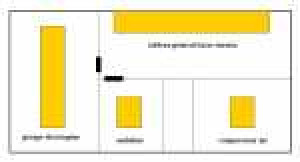In a chemical plant, a fire broke out at 12.59 pm in a substation supplying a hydrazine hydrate unit. An electrical fault on a cooling water pump caused a generalised short circuit on an electrical tower. The fire alarm was triggered at 1.00 pm. The fire spread to the other towers of the panel through the subfloor. The 400 V circuit breaker located upstream was blocked and did not function. The fault current passed through the 13,000 / 400 V transformer, there was overpressure and an oil leak (Buchholz relay against overpressure not connected) followed by a primary side homopolar fault causing the 13 kV circuit breaker to trip. The absence of voltage caused the diesel generator set to stop but the switchover to the emergency system failed as the automatism was damaged by the fire. The smoke spread to the UPS room whose door remained opened. The UPS stopped when a high temperature (> 40 °C) was reached causing the loss of control. The equipment switched over to safety mode. Due to the lack of power supply, the cooling system, agitation and the internal and external emergency plan siren were no longer functional. Since the ongoing reaction was exothermic, the reactor temperature (100°C instead of 50°C) and pressure (0.6 bar) increased. The internal emergency plan was triggered at 1.35 pm. The fire was brought under control by the onsite fire-fighters at 1.50 pm. The opening of a safety valve of a hydrazine unit column released about 280 kg of ammonia (NH3) into the atmosphere. A fire nozzle sprayed water on the tower body to cool it. The external emergency plan warning panels on the road to the plant were activated. At 2.15 pm, a water curtain was implemented to disperse the cloud and the NH3 concentration was measure in a neighbouring village (< 10 ppm). At 2.38 pm, since the NH3 concentration was 3 ppm, the external emergency plan warning panels were deactivated. At 2.40 pm, additional water curtains were set up after a rupture disc (0.5 bar) exploded on another tower. The fire water was stored in a workshop tank. During the accident, the NH3 concentrations measured were 10 ppm (olfactory threshold = 5 ppm, TLV-TWA = 25 ppm).
No casualties were reported. Operations stopped for several days. Several measures taken such as designing an emergency cooling circuit, improving circuit breaker maintenance, connecting Buchholz relay, sectoring UPS system, electric boards, generator sets, etc.
Download the detailed report in .pdf format (113 Kb)





